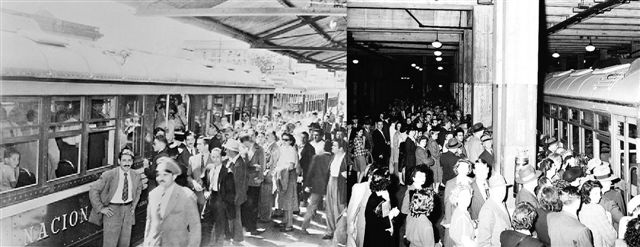Pacific Electric Hollywood Cars: Doing What They Did Best
By Ralph Cantos
These two photos, taken about ten years and ten thousand miles apart, are remarkably similar in the fact that they both show the fantastic ability of PE’s Hollywood cars to move vast amounts of commuters in “comfort-speed-and-safety.” The photo on the left shows the inaugural rush hour run of the first set of second-hand PE cars in Buenos Aires in early 1953. The photo on the right shows a three-car rush hour train of Hollywood cars at the Subway Terminal in 1943.
In the Buenos Aires photo, the man in the tie looking at the camera is very smug and proud of this train. He must have wondered how those stupid Americans could have let such excellent commuter rail cars slip away. The Hollywood car would serve the commuters of Buenos Aires well into the 1970s.
Back here in Los Angeles as the decades passed, murals of Hollywood cars would dot the landscape as traffic chocked freeways became the norm.
Then in the late 1980s LA City planners finally “bit the bullet” and decided it was time to put the PE back together again — in short, one HELL of a Humpty Dumpty. So now, at a cost of hundreds of billions of our tax dollars, rail service is being restored to areas of Southern California once served by not only the PE Hollywood cars, but rail cars of the LARY / LATL. In every case, the public officials tout the fact that “superior rail service returns once again” One can only wonder if rail service was so good in the first place, WHY THE HELL did LA City officials sit on their asses while the likes of Metropolitan Coach Lines and California Division of Highways (today’s CalTrans) were allowed to destroy the original rail system in the name of “progress.”
Ralph Cantos Collection



During this same period (the 1940s) Chicago and Boston established quasi-governmental entities to take over public transit. LA didn’t get the message until the rail systems were on their last legs. As long as the transit operations were “private” companies, there would be resistance to using taxpayer money to rebuild the system. PE was a special case; being owned by Southern Pacific, the memories of the “Octopus” might have caused doubts in minds of some of the older “city fathers.” Regarding the end of the Northern District when the Highway dept. preempted the Aliso St. slot for the 101 Freeway, as far back as the 1920s there had been proposals to extend the elevated tracks going east from 6th & Main all the way to the LA River to eliminate downtown street running, but the LA Times killed this idea with images of New York and Chicago “L” trains blighting the city, while in truth the proposed route would go through a grimy industrial area.
Hollywood Cars, Elevens, and Key Bridge Units had lengthy second lives in Buenos Aires (PCCs served as well, but for a short period). I rode them all and enjoyed their comfort, class and great (north) American design during their heyday in Argentina. Ferrocarril General Urquiza became a mini PE south, with their well equipped Lynch Workshops (a small version of Torrence), performing miracles in transforming these great electric cars for local service and prolonging their lives to the 50-year mark. Buenos Aires got its money’s worth. BTW: The railroad line still exists with Toshiba cars. The local museum at Lynch has one unrestored Hollywood cars and some PE electric locos.
Fantastic info, Tito! Thanks for sharing!
Tito, does anyone know just what became of the PCC’s? Any photos of PCC’S being scrapped? The Hollywood car you are talking about, is that the line car? Ralph Cantos
Hi Ralph:
Yes the Hollywood Car is the line car that is stored at Lynch. I’ve seen some recent pictures of it and, unless things changed dramatically, it is in a pretty bad state. The PCCs are long gone. There is no record that any survived scrapping back in the 1960s. I have never seen any pictures of them being scrapped, but I am sure some must exist. The policy back then when it came to electric traction was to eliminate every trace of it. The branch line over which the PCCs operated was shut down once they were gone.
Different country, same government attitude toward historical resources. To quote Buckaroo Bonzai, “No matter where you go, there you are.”!
Can some one tell me the overall length of the 600-series Hollywood cars, or direct me to a drawing of these cars? Thanks….
Tom, look on page 189 of Ira Swett’s CARS OF THE PACIFIC ELECTRIC – SPECIAL #28. The Hollywood cars were 52′-2″ from bumper to bumper. the car body was 8′-10-1/4″ wide.